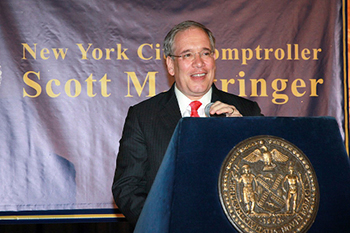Overcrowding Audit Highlights Major Problem for NYC Schools
 NEW YORK — Nearly one in three New York City public schools experienced overcrowding during the 2012 school year, an issue neither documented nor tracked by the city’s Department of Education, according to an audit released by city Comptroller Scott M. Stringer. According to the July 9 audit, the New York City Department of Education (DOE) lacked any evidence of steps taken to implement, track and act upon recommendations to ease overcrowding in the city’s schools between 2010 and 2012.
NEW YORK — Nearly one in three New York City public schools experienced overcrowding during the 2012 school year, an issue neither documented nor tracked by the city’s Department of Education, according to an audit released by city Comptroller Scott M. Stringer. According to the July 9 audit, the New York City Department of Education (DOE) lacked any evidence of steps taken to implement, track and act upon recommendations to ease overcrowding in the city’s schools between 2010 and 2012.
According to the DOE, 36 percent of school buildings were over-utilized between 2010 and 2012, despite the fact that more than 16,000 new seats were created over that same period. Some 33 percent of primary schools were determined to be overcrowded by as much as 138 percent in 2012, with middle and high schools experiencing overcrowding at a rate of 12 percent and 32 percent, respectively.
The audit further identified the 59 most over-utilized public school buildings in New York City, with over-utilization ranging from 133 to 238 percent. The DOE was unable to provide any evidence or documentation showing its offices had made recommendations to alleviate the situation.
“With significant overcrowding in schools across New York City, the Department of Education simply wasn’t interested in finding out what policies worked to reduce class sizes and help our children achieve their full academic potential,” Stringer said in a release. “What gets measured gets managed and in this case, DOE didn’t keep records of the remedial actions it took to reduce overcrowding, let alone what worked and what didn’t. Every child deserves enough space to be able to learn. This audit found that there is much more to be done before DOE gets a passing grade on reducing overcrowding in schools.”
According to the release, Stringer’s audit focused on the efforts of DOE’s Offices of Portfolio Management and Space Planning to alleviate overcrowding in the “Enrollment, Capacity and Utilization Report,” compiled by the School Construction Authority (SCA). DOE data indicated that between 2010 and 2012, over-utilization rates for primary schools increased 2 percent, while middle schools saw a 3 percent jump. However, high school over-utilization rates actually decreased 5 percent.
The audit also found that the DOE’s Office of Portfolio Management and the Office of Space Planning did not track whether recommendations or efforts to reduce over-utilization were either implemented or successful. Furthermore, actions taken by the two offices to identify, track and address overcrowding were not well documented, preventing auditors from conducting a proper assessment.
In response, the audit urged DOE to begin compiling written policies and procedures detailing steps the offices are required to take to address overcrowding, and to maintain documentation on proposed recommendations and solutions. Auditors also stressed the implementation of a system to track over-utilized buildings, assess recommendations and examine discontinuing the use of transportable classrooms at specific schools. DOE largely agreed to follow the recommendations.
“Step one in alleviating school overcrowding is providing an honest, transparent account of space that exists in our school buildings,” Stringer said. “Step two is ensuring that there are coherent internal structures, policies and protocols in place to identify, track and address the school overcrowding. DOE must continue to work on these issues as it addresses the overcrowding crisis in our schools.”
